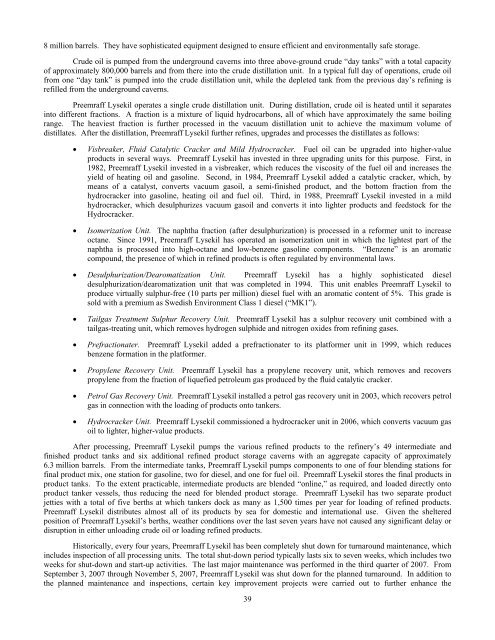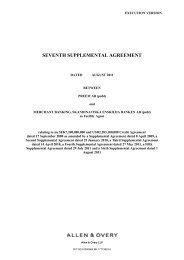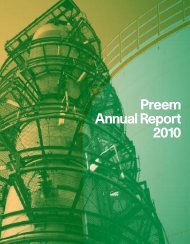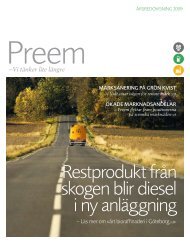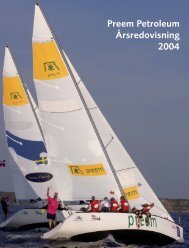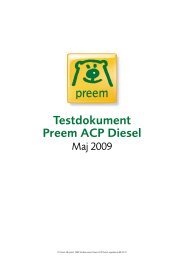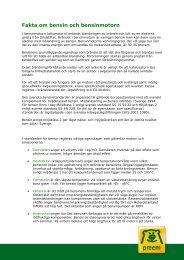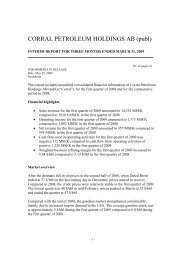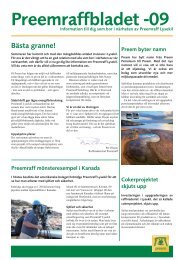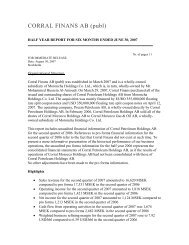Corral Petroleum Holdings AB (publ) Business Update ... - Preem
Corral Petroleum Holdings AB (publ) Business Update ... - Preem
Corral Petroleum Holdings AB (publ) Business Update ... - Preem
You also want an ePaper? Increase the reach of your titles
YUMPU automatically turns print PDFs into web optimized ePapers that Google loves.
8 million barrels. They have sophisticated equipment designed to ensure efficient and environmentally safe storage.Crude oil is pumped from the underground caverns into three above-ground crude “day tanks” with a total capacityof approximately 800,000 barrels and from there into the crude distillation unit. In a typical full day of operations, crude oilfrom one “day tank” is pumped into the crude distillation unit, while the depleted tank from the previous day’s refining isrefilled from the underground caverns.<strong>Preem</strong>raff Lysekil operates a single crude distillation unit. During distillation, crude oil is heated until it separatesinto different fractions. A fraction is a mixture of liquid hydrocarbons, all of which have approximately the same boilingrange. The heaviest fraction is further processed in the vacuum distillation unit to achieve the maximum volume ofdistillates. After the distillation, <strong>Preem</strong>raff Lysekil further refines, upgrades and processes the distillates as follows:Visbreaker, Fluid Catalytic Cracker and Mild Hydrocracker. Fuel oil can be upgraded into higher-valueproducts in several ways. <strong>Preem</strong>raff Lysekil has invested in three upgrading units for this purpose. First, in1982, <strong>Preem</strong>raff Lysekil invested in a visbreaker, which reduces the viscosity of the fuel oil and increases theyield of heating oil and gasoline. Second, in 1984, <strong>Preem</strong>raff Lysekil added a catalytic cracker, which, bymeans of a catalyst, converts vacuum gasoil, a semi-finished product, and the bottom fraction from thehydrocracker into gasoline, heating oil and fuel oil. Third, in 1988, <strong>Preem</strong>raff Lysekil invested in a mildhydrocracker, which desulphurizes vacuum gasoil and converts it into lighter products and feedstock for theHydrocracker.Isomerization Unit. The naphtha fraction (after desulphurization) is processed in a reformer unit to increaseoctane. Since 1991, <strong>Preem</strong>raff Lysekil has operated an isomerization unit in which the lightest part of thenaphtha is processed into high-octane and low-benzene gasoline components. “Benzene” is an aromaticcompound, the presence of which in refined products is often regulated by environmental laws. Desulphurization/Dearomatization Unit. <strong>Preem</strong>raff Lysekil has a highly sophisticated dieseldesulphurization/dearomatization unit that was completed in 1994. This unit enables <strong>Preem</strong>raff Lysekil toproduce virtually sulphur-free (10 parts per million) diesel fuel with an aromatic content of 5%. This grade issold with a premium as Swedish Environment Class 1 diesel (“MK1”).Tailgas Treatment Sulphur Recovery Unit. <strong>Preem</strong>raff Lysekil has a sulphur recovery unit combined with atailgas-treating unit, which removes hydrogen sulphide and nitrogen oxides from refining gases.Prefractionater. <strong>Preem</strong>raff Lysekil added a prefractionater to its platformer unit in 1999, which reducesbenzene formation in the platformer.Propylene Recovery Unit. <strong>Preem</strong>raff Lysekil has a propylene recovery unit, which removes and recoverspropylene from the fraction of liquefied petroleum gas produced by the fluid catalytic cracker.Petrol Gas Recovery Unit. <strong>Preem</strong>raff Lysekil installed a petrol gas recovery unit in 2003, which recovers petrolgas in connection with the loading of products onto tankers.Hydrocracker Unit. <strong>Preem</strong>raff Lysekil commissioned a hydrocracker unit in 2006, which converts vacuum gasoil to lighter, higher-value products.After processing, <strong>Preem</strong>raff Lysekil pumps the various refined products to the refinery’s 49 intermediate andfinished product tanks and six additional refined product storage caverns with an aggregate capacity of approximately6.3 million barrels. From the intermediate tanks, <strong>Preem</strong>raff Lysekil pumps components to one of four blending stations forfinal product mix, one station for gasoline, two for diesel, and one for fuel oil. <strong>Preem</strong>raff Lysekil stores the final products inproduct tanks. To the extent practicable, intermediate products are blended “online,” as required, and loaded directly ontoproduct tanker vessels, thus reducing the need for blended product storage. <strong>Preem</strong>raff Lysekil has two separate productjetties with a total of five berths at which tankers dock as many as 1,500 times per year for loading of refined products.<strong>Preem</strong>raff Lysekil distributes almost all of its products by sea for domestic and international use. Given the shelteredposition of <strong>Preem</strong>raff Lysekil’s berths, weather conditions over the last seven years have not caused any significant delay ordisruption in either unloading crude oil or loading refined products.Historically, every four years, <strong>Preem</strong>raff Lysekil has been completely shut down for turnaround maintenance, whichincludes inspection of all processing units. The total shut-down period typically lasts six to seven weeks, which includes twoweeks for shut-down and start-up activities. The last major maintenance was performed in the third quarter of 2007. FromSeptember 3, 2007 through November 5, 2007, <strong>Preem</strong>raff Lysekil was shut down for the planned turnaround. In addition tothe planned maintenance and inspections, certain key improvement projects were carried out to further enhance the39


